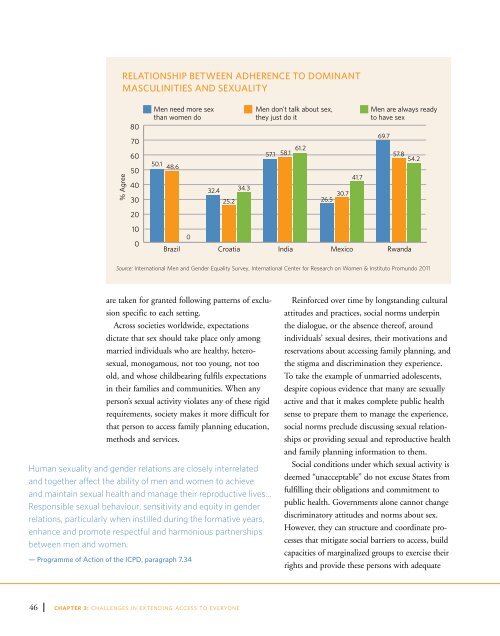State of World Population 2012 - Country Page List - UNFPA
State of World Population 2012 - Country Page List - UNFPA
State of World Population 2012 - Country Page List - UNFPA
Create successful ePaper yourself
Turn your PDF publications into a flip-book with our unique Google optimized e-Paper software.
Relationship between adherence to dominant<br />
masculinities and sexuality<br />
80<br />
70<br />
60<br />
Men need more sex<br />
than women do<br />
Men don’t talk about sex,<br />
they just do it<br />
57.1 58.1<br />
61.2<br />
Men are always ready<br />
to have sex<br />
69.7<br />
57.8<br />
54.2<br />
50.1 48.6<br />
32.4<br />
% Agree<br />
50<br />
40<br />
30<br />
25.2<br />
34.3<br />
26.5<br />
30.7<br />
41.7<br />
20<br />
10<br />
0<br />
0<br />
Brazil Croatia India Mexico Rwanda<br />
Source: International Men and Gender Equality Survey, International Center for Research on Women & Instituto Promundo 2011<br />
are taken for granted following patterns <strong>of</strong> exclusion<br />
specific to each setting.<br />
Across societies worldwide, expectations<br />
dictate that sex should take place only among<br />
married individuals who are healthy, heterosexual,<br />
monogamous, not too young, not too<br />
old, and whose childbearing fulfils expectations<br />
in their families and communities. When any<br />
person’s sexual activity violates any <strong>of</strong> these rigid<br />
requirements, society makes it more difficult for<br />
that person to access family planning education,<br />
methods and services.<br />
Human sexuality and gender relations are closely interrelated<br />
and together affect the ability <strong>of</strong> men and women to achieve<br />
and maintain sexual health and manage their reproductive lives...<br />
Responsible sexual behaviour, sensitivity and equity in gender<br />
relations, particularly when instilled during the formative years,<br />
enhance and promote respectful and harmonious partnerships<br />
between men and women.<br />
— Programme <strong>of</strong> Action <strong>of</strong> the ICPD, paragraph 7.34<br />
Reinforced over time by longstanding cultural<br />
attitudes and practices, social norms underpin<br />
the dialogue, or the absence there<strong>of</strong>, around<br />
individuals’ sexual desires, their motivations and<br />
reservations about accessing family planning, and<br />
the stigma and discrimination they experience.<br />
To take the example <strong>of</strong> unmarried adolescents,<br />
despite copious evidence that many are sexually<br />
active and that it makes complete public health<br />
sense to prepare them to manage the experience,<br />
social norms preclude discussing sexual relationships<br />
or providing sexual and reproductive health<br />
and family planning information to them.<br />
Social conditions under which sexual activity is<br />
deemed “unacceptable” do not excuse <strong>State</strong>s from<br />
fulfilling their obligations and commitment to<br />
public health. Governments alone cannot change<br />
discriminatory attitudes and norms about sex.<br />
However, they can structure and coordinate processes<br />
that mitigate social barriers to access, build<br />
capacities <strong>of</strong> marginalized groups to exercise their<br />
rights and provide these persons with adequate<br />
46 CHAPTER 3: CHALLENGES IN EXTENDING ACCESS TO EVERYONE
















